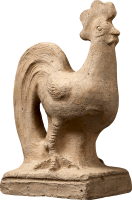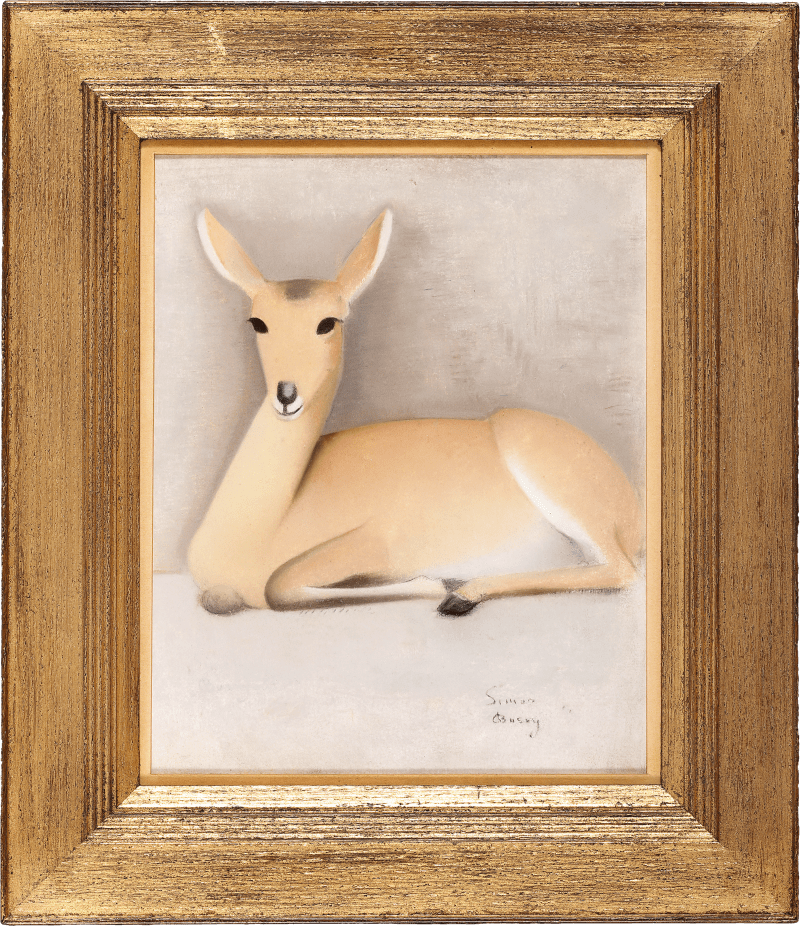

Simon Bussy
(1870-1954) A CockerelProvenance
Working predominantly in pastels and oil paints at the turn of the twentieth century, Simon Bussy here explores the third dimension in the form of a cockerel, believed to have been gifted to Alison Debenham by the artist. This sculpture is thought to be the only work by Simon Bussy using terracotta as a medium.
Simon Bussy was born Albert Bussy in Dôle, Jura in eastern France, the son of a shoemaker, in 1870. He won a local scholarship to study in Paris from 1886, at the Academié Carmen in the Passage Stanislas (James McNeill Whistler’s old teaching school) and was subsequently admitted into the Ecole des Arts Décoratifs.[1] He continued his studies at the École des Beaux-Arts from 1890, studying under E. Delaunay and then Gustave Moreau (known as the ‘Socratic midwife’), and alongside Henri Matisse and Georges Rouault whom he remained close friends. He was later able to offer a letter of introduction to the Bloomsbury Group to...
Working predominantly in pastels and oil paints at the turn of the twentieth century, Simon Bussy here explores the third dimension in the form of a cockerel, believed to have been gifted to Alison Debenham by the artist. This sculpture is thought to be the only work by Simon Bussy using terracotta as a medium.
Simon Bussy was born Albert Bussy in Dôle, Jura in eastern France, the son of a shoemaker, in 1870. He won a local scholarship to study in Paris from 1886, at the Academié Carmen in the Passage Stanislas (James McNeill Whistler’s old teaching school) and was subsequently admitted into the Ecole des Arts Décoratifs.[1] He continued his studies at the École des Beaux-Arts from 1890, studying under E. Delaunay and then Gustave Moreau (known as the ‘Socratic midwife’), and alongside Henri Matisse and Georges Rouault whom he remained close friends. He was later able to offer a letter of introduction to the Bloomsbury Group to visit Matisse in his studio, after which Roger Fry wrote to Bussy in 1911 that he had become ‘completely Matisiste’.[2] In 1897 Bussy managed to secure his first solo exhibition at the Galerie Durand-Ruel, Paris.
In Paris he lodged with Emma Guyiesse, the mother-in-law of fellow student Auguste Bréal who was friends with Roger Fry and Pernel Strachey. Through Pernel he became better acquainted with the Strachey family in London and leased a studio in Kensington where Bussy taught several students including Dorothy Strachey and her cousin Duncan Grant, who would become a key member of the Bloomsbury Group along with Roger Fry.[3] Whilst painting in London a spirit-lamp exploded in Bussy’s studio, threatening to seriously damage his sight. After spending several days in hospital he was nursed at the Strachey home by Dorothy Strachey, who he would marry in 1903.
The couple moved to Roquebrune in the south of France, spending summers in England and Scotland, where he is believed to have met Alison Debenham, former owner of this work. Alison Debenham was the daughter of Sir Ernest Debenham who owned Debenhams department store. Like Bussy, she was also a painter, moving to Paris in 1928 and then to the south of the country where she studied with the artist.
Bussy’s career commenced as a portraitist but as his work developed, he turned almost entirely to landscape painting, producing small detailed sketches of birds, animals and fishes for which he often visited London Zoo. Edgar Degas once complemented Bussy saying, ‘you draw your landscapes, like human beings, I like that.’
Bussy remains a vital connection to the Bloomsbury Group and in particular the career of Duncan Grant who described his master’s lessons; ‘[they] remain with me as the best I have ever received.’[4]
[1] M.A. Caws and S.B. Wright, Bloomsbury and France: Art and Friends, (Oxford, 1999), p.327.
[2] M.A. Caws and S.B. Wright, Bloomsbury and France: Art and Friends, (Oxford, 1999), (247-248).
[3] M.A. Caws and S.B. Wright, Bloomsbury and France: Art and Friends, (Oxford, 1999), p.327.
[4] M.A. Caws and S.B. Wright, Bloomsbury and France: Art and Friends, (Oxford, 1999), p.327.











